Table of Contents
I don’t believe that there’s any one way to do SEO well, but there’s a clear and obvious approach that doesn’t work. And, unfortunately, it’s one of the most common ones out there. It’s the 60-page SEO audit. The “strategy” that is actually just random acts of SEO. And results that aren’t delivering ROI (e.g., traffic for the sake of traffic).
We speak with prospective clients all the time who are frustrated with their lack of SEO growth despite a strong investment. In most of these cases, their agency is executing an SEO plan that’s siloed from the business outcomes that their client cares about.
An outcome-driven SEO strategy drives value by aligning execution with the client’s goals. Here are the main benefits of this approach:
- Buy-in: Your strategy is compelling to clients because it communicates growth outcomes that they care about
- Value: Your efforts are concentrated on opportunities that will drive growth where it matters most
- Vision: Your strategy lays out a clear roadmap to achieve defined outcomes that will keep all parties aligned
Let’s explore what it takes to build an outcome-driven SEO strategy.
The Key Elements of Outcome-Driven SEO
Group Recommendations into Initiatives that influence Business Outcomes
Here’s how most SEO strategies are built. Recommendations are tied to SEO objectives, like “Technical Optimization”, “On-Page Optimization”, or “Off-Page Optimization”.
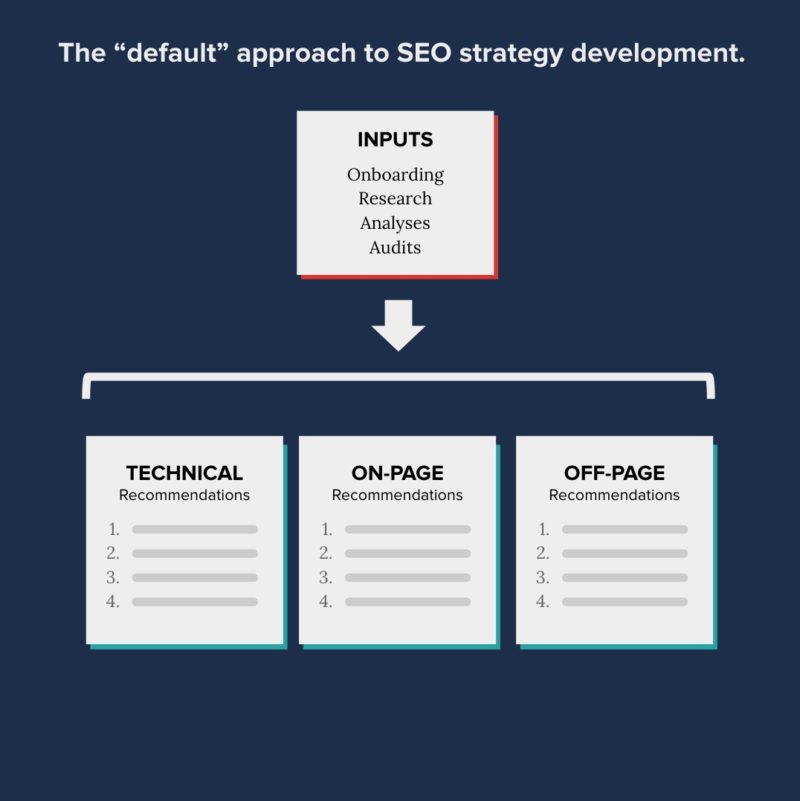
What’s wrong with this approach? It’s SEOs forcing SEO objectives on their clients.
Of course, that doesn't mean the recommendations are bad. They’re just organized poorly for driving the results that clients care about.
Instead, group your recommendations into distinct initiatives that ladder up to a business outcome that your client wants to achieve.
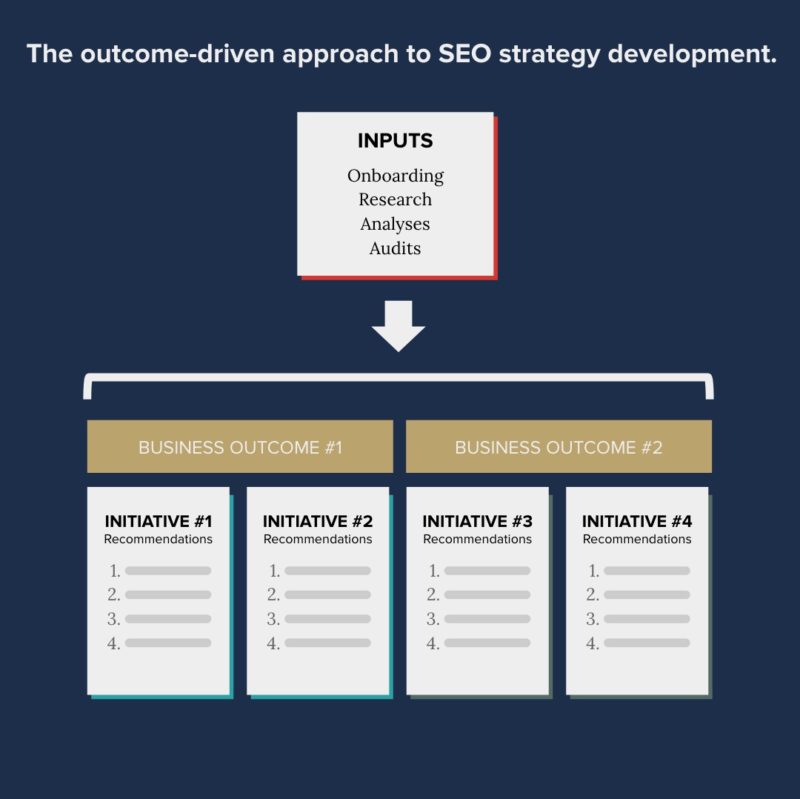
What you’ll find is that you’ll have initiatives that contain a mix of technical, on-page, and off-page recommendations. And, you’ll de-prioritize or get rid of recommendations that won’t impact the client’s goals.
Clients have little time to learn what exactly these SEO objectives, like "Technical Optimization", actually mean. So, how can you expect them to get excited about your strategy when it’s presented that way? Frame recommendations as opportunities to drive them towards their business goals and watch them buy in!
Present the Opportunity, Not the Issue
Early in my SEO career, I’d get excited to show my client all of the issues I uncovered in their audit. Hey, look at all of the things we can fix!
But, the client’s reaction was never what I expected it to be. Instead of getting excited themselves, I more often saw looks of defeat or frustration on their face. Why?
Because it’s not fun to be told everything that’s wrong with you for an hour straight. Thankfully, a subtle but powerful change in your approach can change the client’s entire tone.
Frame issues as opportunities. Share the upside that can be achieved by carrying out your recommendations.
Here are a few tips to help you ensure that you’re doing a good job of presenting opportunity:
- Call out the KPIs and SEO signals that you expect to see impacted by each recommendation.
- Challenge yourself to present the upside in terms of dollars. Don’t worry about being exact. It’s better to be bold and share one possible outcome, rather than understate the opportunity.
- If you can’t make a good case, then you should consider not pushing the recommendation. Relegate it to an SEO punch list that you can save for a rainy day.
Prioritize Recommendations by Effort & Impact
Not all recommendations are equal. They vary in their feasibility and their impact on the outcomes that your client wants to achieve.
At Uproer, we have a simple High/Medium/Low ranking system that we assign to each recommendation’s expected level of effort and impact. Here’s what you should consider when prioritizing recommendations:
- Know your client: Filter your recommendations through your client’s unique situation to properly prioritize them. A given recommendation may be High Impact/Low Effort for one client and Low Impact/High Effort for another. Here are some common considerations:
- Resource limitations (e.g., your client is trying to hire a new developer and can’t provide you near-term technical)
- Technology limitations (e.g., your client is on a CMS that doesn’t have a native solution for your recommendation)
- Upcoming initiatives (e.g., your client is re-platforming in a few months which changes how you view the value of technical improvements for the current website)
- Consider how to best order your recommendations: Tackle the High Impact/Low Effort recommendations first for quick wins, right? Not always.
- Example: Your ecommerce client can improve keyword targeting on category pages for quick ranking gains (High Impact/Low Effort), but crawl issues are causing many of these pages to fall in and out of the index (High Impact/High Effort). In this scenario, the crawl issues need to be resolved first before your keyword targeting will have any meaningful impact.
How to Create an Outcome-Driven SEO Strategy
Conduct a thorough onboarding
The main goal of onboarding is to define the client's business outcomes, which are your starting point for creating an outcome-driven SEO strategy. Some clients will have these goals ready for you. For others, you’ll need to help guide them there by asking the right questions.
4 Tips for Onboarding Clients Successfully
1. Be genuinely curious about their business
- Adopt the mindset of a potential customer and spend time on their website before the onboarding meeting. Do this to surface questions about anything that stands out, like information gaps, their user experience, etc.
- Don’t be afraid to challenge your client's assumptions. Ask “why?” to extract the deep insights that will help you build a strategy.
- Examples:
- Client: “Our space is very competitive in search" / Uproer: “What makes you say that?”
- Client: “Our last SEO agency wasn’t good” / Uproer: “How so?”
- Examples:
- Ask for product demos/samples to get to know their products or services
2. Make it a conversation, not a questionnaire
- Ask open-ended questions to extract full answers that may yield important insights. Stay away from questions that can be answered with a simple “yes” or “no”.
- Have questions prepared, but be open to diving deeper into topics that clearly matter to the client.
- Record the meeting or assign someone from your team to be the note-taker so that you can actively listen instead of frantically taking notes.
3. Treat your first onboarding meeting as a launching point for future conversations
- Your contact may not have all the answers. Who do they reference when they can’t answer a question fully?
- Listen for phrases like the ones below and ask to talk directly with these people:
- “That’d be a good question for our sales team…”
- “I’ll have to see if [Brian/Becky/etc.] knows that one…”
- Listen for phrases like the ones below and ask to talk directly with these people:
4. Come up with hypotheses as you go that you can take into your research
- In a good onboarding meeting, the ideas will start percolating. Voice these ideas to gauge the client’s interest, which will give you things to dig into as your research and auditing get underway.
Use what you learned during onboarding to inform where you should spend your time researching and auditing
At the conclusion of your onboarding process, you should have your client’s desired business outcomes defined and a few hypotheses on how SEO can help get them there.
Before diving into your SEO audits and analyses, consider where you should be focusing your time to drive the greatest value. Which audits and analyses should be prioritized? Which topics or areas of the website should get more of your attention?
Here are a few common scenarios that will affect how you prioritize your time:
- The client’s business is changing and they want their SEO strategy to help drive them to where they’re going, not focus on where they’ve been
- The client places a much higher priority on one audience over others
- The client places a much higher priority on one product line or service offering over others
- The client is re-platforming their website soon, which should make you think about how deep your technical auditing needs to go on their current website
- The client has resource or technology limitations that will impact your ability to execute certain types of recommendations down the line
- The client has an especially short or long sales cycle, which should influence the stages of the customer journey that you focus on
- The client is starting with a highly mature SEO strategy or starting from scratch, which should influence how you prioritize analyzing existing content versus surfacing new content opportunities
- The client is positioned in a space of especially high or low SEO competition, which should influence where you spend your time in content research
Create a performance narrative
A bad marketing habit is sharing metrics for the sake of sharing metrics. Instead, let’s use data to tell a story that clients care about.
The purpose of your analyses of past performance and the competition is to answer this question:
Why is the client’s current approach to SEO not driving growth towards their desired business outcomes?
In answering this question, you should identify what they’re doing well, where they’re falling short, what’s holding them back, and what competitors are doing to accelerate their growth.
Here are some important questions that you should seek to answer as you dig into the data:
- What trends are you identifying that are moving the client towards or away from their business goals? Consider the client’s performance as well as market trends.
- Where is the client gaining or losing their competitive advantages as it relates to their goals?
- How are distinct areas of the site performing relative to each other? Are they all moving in the same direction or are their notable pockets of growth or decline?
- How is their brand demand impacting SEO performance? How does this compare to non-brand?
- Where are competitors seeing growth? How does this relate to the client’s performance?
- How does the client’s SEO performance compare across stages of the customer journey?
- What’s driving conversions? Are conversions weighted towards certain topics, content types or sections of the website?
- What obstacles are impeding growth towards their business goals?
By answering these questions, you’ll be able to build a narrative that will help you and the client understand why SEO is failing to achieve their goals. And, like onboarding, this exercise will help you to determine where you need to spend your time going forward.
Build an outcome-driven SEO roadmap
With the business outcomes defined, a clear performance narrative established, and a strong sense of where you’ll spend your time developed, it’s time to dive into the research and audits that will surface SEO opportunities.
Adam Gent with The SEO Sprint published a brilliant guide to building outcome-driven SEO roadmaps. I strongly suggest giving it a read. What I have below is a summary/interpretation of some of the main points from that article.
Organize opportunities (recommendations) into initiatives that ladder up to outcomes
How to structure your SEO roadmap:
- Outcome: The business goal
- Initiative: A clear action intended to influence a certain outcome
- Opportunity: The tactics being recommended to drive an initiative forward
- Initiative: A clear action intended to influence a certain outcome
Here’s a real example of this structure presented in an outcome-driving SEO roadmap:
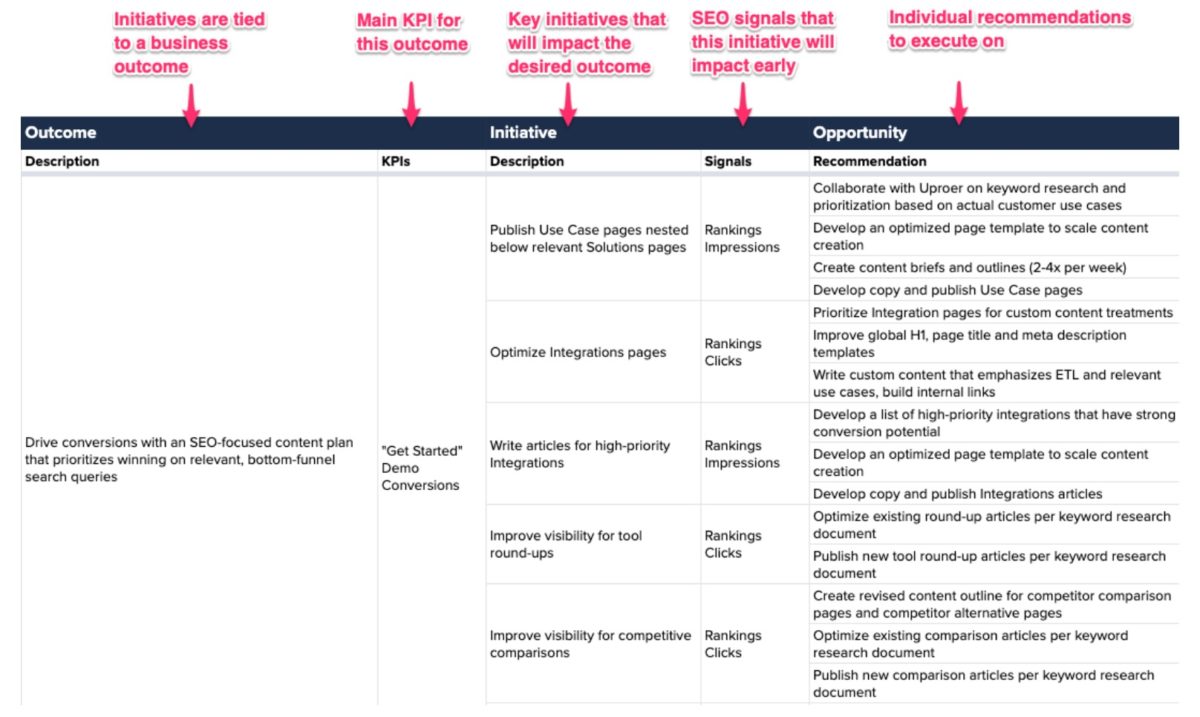
Notice that the roadmap also defines the main KPI for the outcome as well as signals we expect to see impacted by each initiative.
Signals are secondary metrics, and often leading indicators, that we can use to gauge if our efforts are proving successful.
Prioritize each opportunity by effort & impact and define other key attributes
Here’s an expanded view of the SEO roadmap above showing prioritization and other important information for each opportunity:
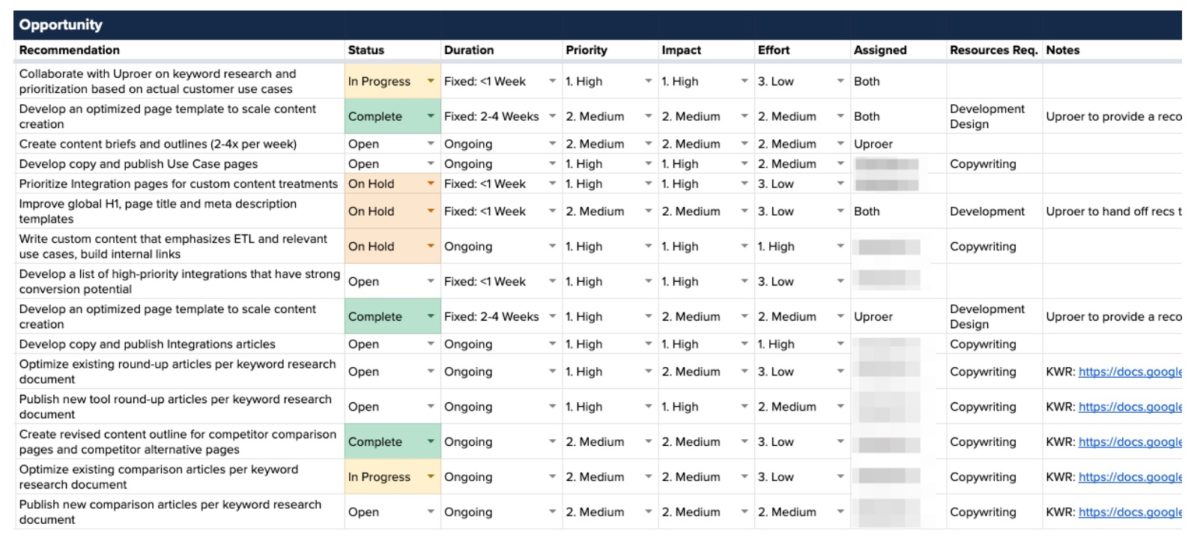
We covered the importance and key considerations of effort & impact prioritization early in this guide. But those aren’t the only attributes that are important to define:
- Status: Track the progress of each recommendation.
- Duration: Some SEO tactics are fixed while others are ongoing. This one is important in setting expectations with the client.
- Assigned: Set who is responsible for executing each recommendation.
- Resource Requirements: Anticipate the additional expertise required to support each recommendation.
- Notes: Drop in any helpful information or resources for each recommendation.
Develop a performance forecast
Your outcome-driven SEO strategy has been built and the client is prepared to make a significant investment to pursue it. But before they do, the natural question is: “What’s the return we should expect to see from this strategy?”
SEO is a complex practice that’s influenced by many factors beyond our control. This is why many SEOs duck forecasting for the comfortable answer of “it depends…”
Forecasting can be a difficult proposition and one where the adage “perfection is the enemy of good” certainly applies. Rather than getting hung up on being exact, forecasting should be approached from the perspective of providing a reasonable prediction assuming that things generally go as planned.
There are a number of forecasting techniques that can be used (and combined) to predict the growth opportunity. The technique(s) you choose to use should depend on what’s viewed as most appropriate for the individual client.
Here are a few of the forecasting techniques we commonly use at Uproer:
- Draw on the performance of existing or past clients who compare similarly to this client
- Find a reasonable comparison, a technique promoted by SEO MBA
- Use a forecasting model:
- Forecasting SEO by Erudite
- SEO Forecasting in Google Sheets by Moz
- The ROI of SEO by Kevin Indig
Here’s an example of a performance forecast that was presented to an Uproer client. It shows where we expect to see traffic growth across the website, which is based on the opportunities and initiatives we’ll be pursuing in our strategy.
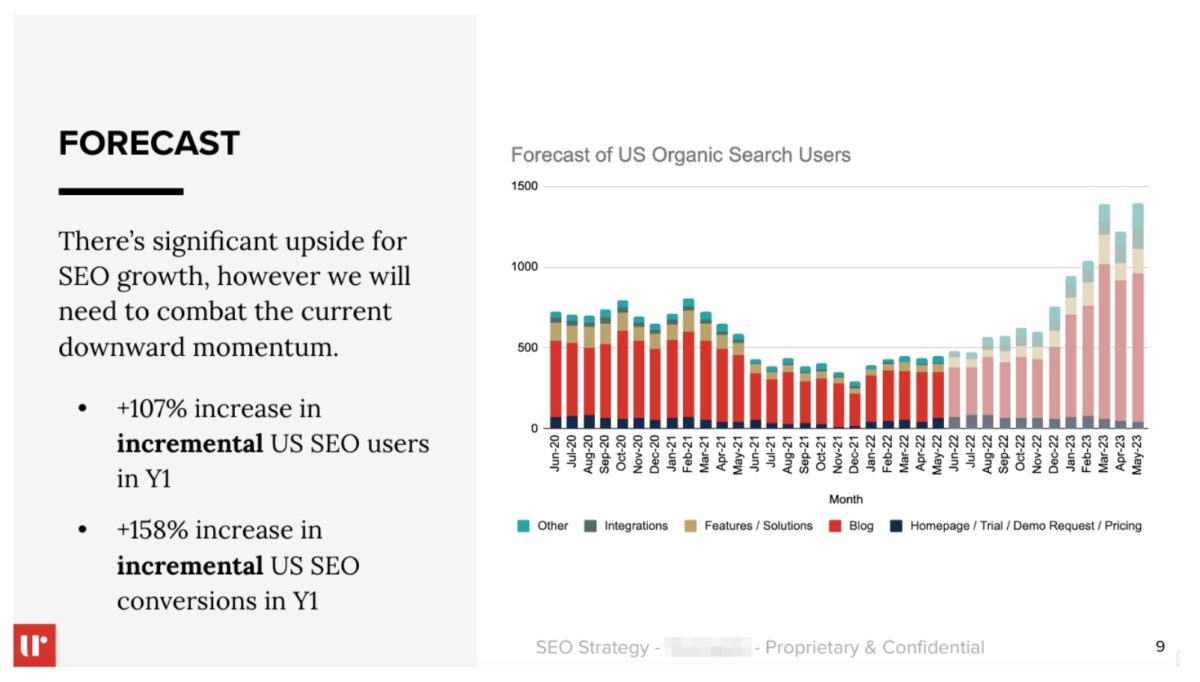
That traffic growth was used to estimate conversion growth based on the website’s existing conversion rates.
Related reading: How Long Does SEO Take?
Conclusion
SEOs can benefit themselves and their clients by moving away from strategies that are built around SEO objectives and, instead, developed from the business outcomes that matter to their clients.
If you’re looking for an SEO agency that can help you develop and execute an outcome-driven SEO strategy, let’s chat!

